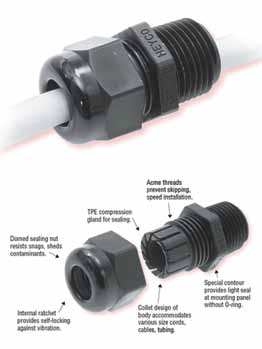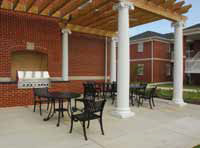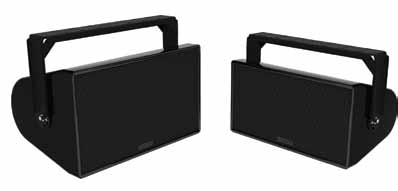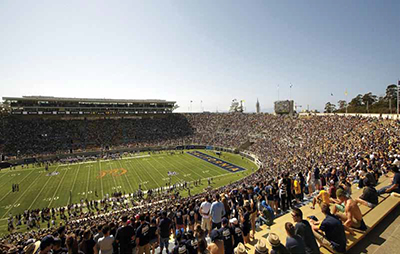Techniques and Tricks to Offer the Best Audio for End Users, Wherever They Are.
Whether you’re holding an outdoor event or you just want to create an environmental “soundscape” on your campus or office park, dealing with outdoor acoustics presents a different set of challenges compared to indoor sound. The same rules don’t necessarily apply.
Remember that sound is nothing more than the sensory effect we experience when colliding air molecules interact with our hearing mechanism. Anything that affects how those molecules collide and the path they take to get to our ears affects what we hear.
Indoors, the main issues are reflection and absorption from surfaces and materials in the room. This is the great art/science known as “room acoustics.” Room acoustics still apply outdoors; it’s just that the room is much larger, and walls, ceilings, and floors are not as predictably located.
1. Use enough loudspeakers
Depending on the size of the area you want to cover with sound, you’ll probably need more loudspeakers outdoors. With the same amount of amplifier power, a pair of loudspeakers on stands in the middle of a field will sound much quieter compared to the same loudspeakers indoors, because there are fewer reflections to add energy to the total sound power level heard by a listener.
Define and measure the area you want to cover. For good general coverage outdoors, a useful guideline is to place loudspeakers every 12 to 15 feet. Calculate the number of loudspeakers you need by dividing the length and the width by 15 feet. It’s also helpful to layout your loudspeaker locations on a grid diagram.
If it’s not feasible to distribute the audio throughout the desired listening area, and you need to rely on a single loudspeaker location, it’s still better to use more loudspeakers than to simply increase amplifier power. More surface area, moving more air, will create more sound over a larger area, compared to making fewer loudspeakers work harder with increased power.
2. Pay attention to pattern control
For the critical mid- and high frequencies (most important for speech intelligibility), most loudspeakers use some sort of waveguide device to control the coverage pattern of the sound they produce. However, once the moving air molecules leave the mouth of the waveguide, where they go and the path they take to get to the listener is much less controllable. Indoors, getting good coverage is a little easier since sound is reflected off walls and ceilings. Outdoors, the sound path is at the mercy of environmental conditions, especially wind, humidity, and temperature fluctuations.
Use loudspeakers that claim good pattern control. A loudspeaker that radiates its sound omnidirectionally, will deliver sound to a wide area, but less energy will reach the farthest listeners. A loudspeaker with some pattern control will direct more sound to the area within its “pattern” (typically 90 degrees), so more sound will reach the more distant listeners.
3. Use weather resistant products
Most audio products are composed of various types of metals and wood. These are great for producing good sound but not so great for enduring the extremes of outdoor environments. Audio electronics are inherently more sensitive to environmental conditions, and should always be protected from moisture, either by locating components indoors or by housing them in protected enclosures. The National Electrical Manufacturers Association (NEMA) and the European Committee for Electro Technical Standardization (CENELEC) have developed standards for protecting electronics in outdoor applications. IEC standard 60529 define levels of “ingress protection” (IP) for devices or enclosures to be able to withstand dust, water, and other environmental conditions. An IP rating normally has two numbers defining:
1. Protection from solid objects or materials
2. Protection from liquids (water)

The gland nut has a neoprene rubber gasket situated inside of an iris-like clamping mechanism. When the exterior
cap is tightened, the iris clamp reduces in size, forcing the neoprene rubber gasket to seal against the cable. This
provides a seal that is both dust tight and water-tight (IP66 rated). The gland nut also has an integrated plastic ridge
on the bottom side of the fitting where it screws into the cabinet. As the fitting is tightened into the cabinet, that ridge expands and compresses between the fitting and cabinet, creating a water-tight seal to the cabinet surface.
Source: Community Pro (www.communitypro.com)An IP rating of 54, for example, means that the level of protection from solid objects is 5 on a scale of 0 to 6, 6 is best), and the level of protection from liquids is 4 (on a scale of 0 to 8). Manufacturers like Bud Industries and Pelican Cases offer a wide range of stock or custom-made cases for protecting electronics for outdoor applications.
Loudspeakers for outdoor use are commonly composed of weather-resistant materials like plastics and polymers. But don’t forget that the enclosure is only part of what’s exposed. Unless the audio signal is transmitted wirelessly, the connection is ultimately dependent on metal-to-metal contact, like speakers cables to terminal strips. Exposed to the outdoors, these can corrode over time, or become shorted out by moisture or water. Make sure that these connections are protected. The ageold remedy used to be a squeeze from a tube of silicone sealant over the entire contact area—but some manufacturers have adopted other methods, like using water tight (WT) “gland” connectors on enclosures that are likely to get wet.
While cone loudspeakers are traditionally made from paper or cloth/paper composite, loudspeakers for outdoor applications (especially permanently installed loudspeakers) should have polymer or carbon fiber cones, like Community Pro’s “WET” Series.
4. Don’t aim at hard surfaces
Even though you’re outdoors, reflective surfaces can still be an issue that you’ll need to content with. First of all, gravity requires that most listeners are standing on the ground, and whether they’re on grass, an asphalt parking lot, or in bleachers in a stadium, all of these surfaces are acoustically reflective or absorptive to varying degrees. Loudspeakers located between buildings can be especially tricky, since sound will reflect and bounce between the large, hard surfaces of building exteriors. Just like shouting “Hello!” into a canyon, you’re likely to produce a series of echoes, which can destroy the intelligibility of any audio source—like the CEO’s address to the company— emanating from the loudspeakers.
Be aware of any hard surfaces in the vicinity. Even the ground surface directly in front of the loudspeakers can create destructive reflections. If you can’t avoid directing sound to reflective surfaces, consider “treating” them with acoustically absorptive material— even a blanket or tapestry will help. If you can’t treat the surface, reduce the audio to the lowest possible level to minimize the amount of reflected energy reaching the hard surfaces.
5. Minimize low frequencies
Everyone has had the experience of driving down the road, and suddenly you hear (or more accurately, feel) the low rumble of an approaching car’s subwoofer. You’d be surprised to know that the car’s occupants don’t hear the bass nearly as well as you do. That’s because the long wavelengths of very low frequencies are not effective in small spaces. When you consider that 50 Hz has a wavelength of about 22 feet, you realize that a lot of that energy will extend far beyond the car’s interior.
The lesson is that any sound you produce outdoors will “carry,” often far beyond where you actually want it to go. Low frequencies can be especially annoying and disruptive to other professional environments or neighbors near residential areas. The best remedy is simply to roll-off unnecessary low frequency content on the mixer board. If the program is voice-only, you probably don’t need frequency content below 80 or 100 Hz. For music, unless you are trying to replicate dance music or rock and roll, you can attenuate frequencies below about 50 Hz.
6. Zoning
When using multiple loudspeakers in outdoor applications, it’s helpful to be able to individually adjust and control the levels of each loudspeaker or group. This is called “zoning,” and it’s a common practice in permanent commercial sound system installations, especially in large buildings like airports or even in restaurants. The same concept is important for outdoor environments. Use a multichannel zone amplifier as a way to control volume at each loudspeaker zone.
7. Outdoor noise
One of the biggest problems with outdoor sound is the sound you can’t control, which interferes with your program or event. Environmental sound from other buildings, traffic, airplanes can be distracting and difficult to deal with.
The most effective way to deal with environmental noise is to be sure your sound system has the capability to play over it. You need the right amount of amplifier power and the correct number of loudspeakers. This is also another advantage of using a distributed outdoor sound system design, with multiple loudspeakers located closer to the listeners. Trying to overcome ambient or environmental noise levels from a single location or point source loudspeaker system will result in sound that’s far too loud for listeners located closest to the loudspeakers, and only moderately effective for the farthest listeners.
8. Get loudspeakers closer to listeners
In a perfect world, every listener would have her or his own loudspeaker. In challenging acoustic environments—outdoors or indoors—this would solve most of the problems we encounter, when trying to deliver an intelligible, high quality listening experience to multiple listeners. But this is rarely practical. The next best thing is to locate a manageable number of loudspeakers closest to where the listeners are likely to be located.
This approach avoids the need for excessive sound pressure levels, while also minimizing the sound reflections from hard surfaces, and sound that’s blocked or absorbed by objects in the sound transmission path.
Multiple closer sources will also help deal with wind. Wind can, literally, blow the sound away. It’s the pressure variations (compression and rarefaction of air molecules) that result in the sound we hear. Wind is the mass movement of the air that your sound is conducting through. If that mass movement is away from the audience, or to the side, the sound level they hear is diminished. Getting the loudspeakers closer to your listeners simply minimizes the area over which the wind can re-direct your sound transmission medium—the air.
Mark R. Mayfield is QSC’s cinema marketing manager and a contributing editor of AV Technology magazine.
Outdoor Audio at Union U

Union University in Jackson, Tennessee, was established in 1823 and is tied to the Southern Baptist Convention and the Tennessee Baptist Convention. The university continues to grow and now has an enrollment of 4,050.
AV equipment is spread across a large mulitpurpose gathering room that could host concerts, events, and general student activities; two instructional classrooms; and two outdoor patios with background music; plus areas to lounge and socialize.
The main gathering room features a Panasonic HD projector and a audio system including JBL speakers, Crown amps, Yamaha mixer, and Shure wireless mics. The school’s tech team provides support for large events such as concerts, while students can operate the system for general background music. The outdoor patios use Technomad weatherproof loudspeakers and amplifiers. Student can plug their players into the amplifiers instead of a central processing rack.
Loudspeakers that like to get WET
Most loudspeakers aren’t built for the outdoors, but Community Professional’s WET X Series are.

Community Professional’s WET X SeriesThe enclosures are marine-grade plywood and multi-layer glass composite construction, the same approach used by the world’s largest yacht builders. The company is so confident of the enclosure’s weatherproof nature, they give it a 15-year warranty. The loudspeaker grille is constructed of a layer of UV-resistant synthetic mesh, followed by a layer of reticulated foam, and finished with a layer of steel treated with a proprietary duallayer powder coating process. The result is a grille that provides maximum weather protection with minimal acoustic attenuation. All low frequency drivers in their WET X Series use carbon fiber cones, which are virtually impervious to water and other contaminants. All LF, MF and HF drivers are treated with ferrofluid, a liquid with ferric (iron) particles in colloidal suspension that is injected into each driver’s voice coil gap. The liquid is held in place by the attraction of the iron particles to the driver’s magnetic field. Ferrofluid serves three purposes: it conducts heat from the hot voice coil to the cooler magnetic structure that surrounds the voice coil, it hydraulically dampens mechanical resonance (thereby decreasing distortion) and finally, the fluid forms a liquid seal within the voice coil gap, which inhibits corrosion and oxidation from contact with the air. All internal circuitry is protected from the elements with the company’s proprietary Envirotech coating, which seals sensitive electronic components against the effects of moisture and corrosive or acidic airborne contaminants. For terminal connections, Community offers an inherently weatherproof factory sealed gland nut.
